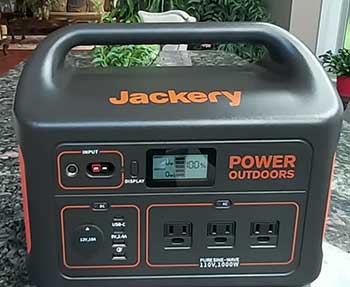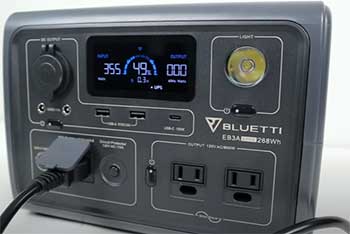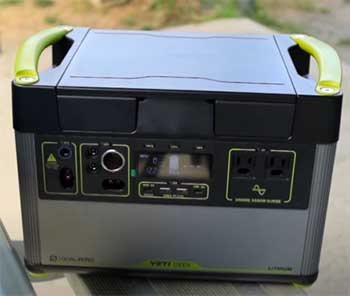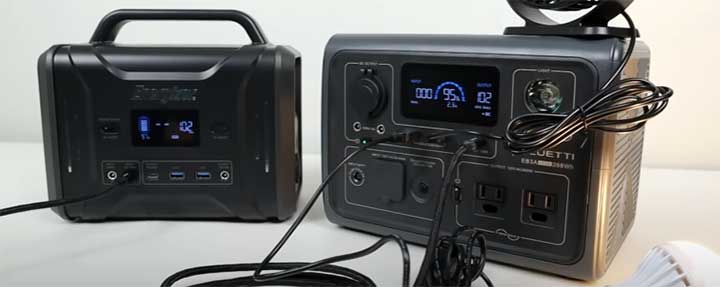When it comes to portable power stations (also commonly called solar generators), three brands stand above the rest — Jackery, Bluetti, and Goal Zero. They each offer a range of products to meet different needs and budgets, from small capacity models designed for camping and outdoor recreation to large solar generator systems capable of powering a home.
But which brand is right for you?
This in-depth comparison examines the pros, cons, capacities, features and real-world performance to name the best portable lithium power station.
Portable Generator Comparison Table
| Model | Capacity | Solar Charging | Outputs | Price |
| Jackery Explorer 1000 | 1002Wh | Yes, 200W max | AC, USB-A, USB-C, car | $999 |
| Bluetti EB70 | 716Wh | Yes, 200W max | AC, multiple USB, wireless charging | $699 |
| Goal Zero Yeti 1000X | 983Wh | Yes, 200W max | AC, USB-A, USB-C, 12V | $999 |
Jackery Portable Power Stations

Jackery debuted its first portable lithium power station, the Explorer 240, back in 2015.
Since then, the brand has continued to grow its Explorer series with its collection of portable power stations and solar panels designed for life on the go.
Its mid-size and large capacity models, especially the Explorer 1000 and 1500, are its most popular for powering appliances, tools and even small home essentials during short-term outages.
Key Jackery Power Station Models:
- Jackery Explorer 240 – small, affordable 242Wh entry-level model
- Jackery Explorer 500 – 518Wh capacity model steps up outputs
- Jackery Explorer 1000 – 1002Wh capacity is Jackery’s bestselling model
- Jackery Explorer 1500 – large capacity 1534Wh solar generator
Jackery Pros
- Excellent quality and durability – products stand up to rugged use
- Very portable and easier to transport than Bluetti models
- Intuitive one-touch button interface is easy to operate
- Faster recharge times than Bluetti (1.8A on Explorer 1500)
- Good availability and often discounted prices
Jackery Cons
- Lower capacity limits runtime for larger loads
- No expandable capacity offered
- Small display is harder to read
- Fans run louder when temperature regulated
Overall, Jackery Explorer models are best for portable essential use given their refined design, reliable performance and faster recharge capabilities. The mid-range 500 and 1000 are its sweet spot for blending capacity, outputs and portability.
Bluetti Portable Solar Generators

Bluetti takes a more modular, expandable approach to its portable power stations.
Models like the EB70, AC200MAX and AC300 invite customers to build out a complete solar generator system with batteries and solar panels tailored to their energy needs.
With advanced monitoring and control through its Bluetti smartphone app, this brand appeals most to solar-savvy DIYers and off-grid enthusiasts.
Large families and even homeowners have been won over by the AC200MAX and AC300 for whole house backup power.
Key Bluetti Power Station Models:
- Bluetti EB70 – tiny 716Wh solar generator for mobility
- Bluetti EB150 – small capacity, affordable entry-level model
- Bluetti AC200MAX – 2048Wh expandable capacity workhorse
- Bluetti AC300 – 3080Wh high capacity modular power center
Bluetti Pros
- Most affordable per watt hours
- Module battery packs enable expanded capacity
- Advanced MPPT solar charging performance
- Full app monitoring and controls
- Powerful 3500W/7000W inverter output
- Can add multiple solar input connections
Bluetti Cons
- Units are much heavier than Jackery’s
- Shorter battery lifespan compared to Jackery
- Slow 1.6A maximum AC charging input
- Doesn’t includesolar panels or batteries
- Premium pricing for modular components
Bluetti systems bring the most long-term usability, customization and best overall value…IF you plan to create a complete solar generator setup. The expandability gives you flexibility as needs evolve over time.
Goal Zero Portable Power Stations

While Goal Zero doesn’t have as many portable power station options as Jackery or Bluetti, its three Yeti models have outstanding reputations for quality, performance and durability.
Goal Zero was first to market with portable lithium power stations over 15 years ago.
So it has vast experience designing robust products purpose-built for off-grid use, emergency preparedness and renewable solar power systems.
Its premium Yeti power stations are compact, sturdy, feature-rich and easy to use.
Like Bluetti, Goal Zero offers a range of expansion batteries and solar panels to scale up your system.
Key Goal Zero Power Station Models:
- Goal Zero Yeti 500X – 505Wh top seller for portable use
- Goal Zero Yeti 1000X – 983Wh highest capacity single unit model
- Goal Zero Yeti 1500X – 1425Wh most affordable per watt hours
Goal Zero Pros
- Very rugged, durable and well-built
- Efficient pure sine wave inverter
- Built-in 120W foldable solar panels on 500X/1000X models
- Separate AC/12V and USB outputs
- Can stack multiple expansion batteries
Goal Zero Cons
- Very heavy – built like a tank!
- Most expensive per watt-hour
- Small screens and basic buttons
- External batteries don’t enable solar charging
- Low wattage MPPT solar charger built-in
Goal Zero Yeti power stations bring exceptional construction to survive real-world use and abuse – especially for off-grid living, outdoor exploration and disaster readiness. Their built-in solar panels provide off-grid charging capabilities out of the box. Chain extra batteries together to enable very long runtimes.
Also Read: How Jackery 880 And 1000 Portable Power Stations Stack Up?
Jackery Vs. Bluetti Vs. Goal Zero Compared
How do these three top portable power station brands stack up across the key buying factors? Let’s compare Jackery, Bluetti and Goal Zero head-to-head:
Price – Across equivalent capacities, Bluetti models deliver more affordable cost per watt-hour. Goal Zero is the premium-priced offering. Jackery prices tend to fall closer to average.
Power & Run Time – Bluetti enables the highest peak power output along with longest runtime when you maximize modular batteries. Goal Zero capacity is limited to its single units, while Jackery fall short here.
Off-Grid Power – Bluetti and Goal Zero both support solar generators systems, but Goal Zero’s built-in solar panel gives it an edge for off-grid use out of the box.
Portability – Jackery power stations are markedly smaller, slimmer and easier to move around by hand. Of the three, Bluetti systems are the largest and heaviest.
Durability – With rubber armor and aluminum casing, Goal Zero Yeti models are undisputedly the most durable and rugged. Jackery Explorer construction is reasonably robust for the average user.
Ease of Use – Jackery takes the crown for most intuitive interface and simpler power station operation overall. Both Bluetti and Goal Zero have more advanced features but require more inputs and setup.
Reputation – All three brands enjoy strong reputations and 4+ star average ratings on online marketplaces like Amazon. But Jackery customer satisfaction scores lead among general consumers.
Portable Power Station Buying Guide

Here what you need to know when comparing different portable power stations (also called solar generators) to make the right buying decision:
- Battery Capacity – The most important spec is the usable battery capacity measured in watt-hours (Wh). This determines runtime. Choose adequate capacity to power target devices for desired length of time. Most range from 500Wh to over 3000Wh.
- Inverter Wattage – Pay attention to continuous and surge power handling to ensure enough overhead for appliances and devices you’ll power. Look for pure sine wave output for sensitive electronics.
- Rechargeability – All portable generators can recharge from wall AC; make sure its input charge rate (amps) is fast enough. Solar and 12V car charging ensures off-grid power regeneration. Consider modular expansion batteries to extend runtimes.
- Outputs – Evaluate number and types of built-in outlets you’ll need (AC, USB-A, USB-C, 12V carport etc). Note some units offer wireless charging. Separate AC/solar capability allows for uninterrupted charging via solar while AC powering devices.
- Physical Size & Weight – Important if you want a highly portable generator to take camping or hiking. The larger the capacity, the bigger in size and heavier in weigh a unit will be. But they all tout handles and/or wheels to aid with transport.
- Brand Reputation & Support – Review brands for product quality, customer service reputation and warranties. While all generators here are lithium-powered, the battery cell suppliers and electronics do vary so check reviews.
- Price Per Watt Hour – General rule of thumb is $1 per watt-hour for smaller units is decent while <$1 per Wh for large systems greater than 1000Wh capacity reflects stronger value.
Also Read: Jackery Vs. Goal Zero Vs. Anker Power Station.
FAQ: Portable Generator Brand Comparison
For most consumers, yes – Jackery currently provides a better balance of portable power station features and value overall compared to Goal Zero:
1. Wider range of capacities to meet different portable power needs
2. Significantly lighter and easier to transport by hand
3. Lower cost per watt-hour capacity across lineup
4. Simpler interfaces and single-button operation
However, Goal Zero Yeti units are markedly more rugged and durable, with the 1000X and 1500X models integrating foldable solar panels. This makes their Yeti models better suited for off-grid and intensive outdoor use.
Both Bluetti and Goal Zero cater well to off-grid solar and renewable electricity users given their emphasis on solar charging capabilities and expansion batteries.
Bluetti regularly wins out when it comes to value given lower costs per watt-hour and breadth of modular system configurations possible as needs grow over time. But Goal Zero Yeti power stations are arguably built tougher and more portable as all-in-one units.
So Bluetti carries advantages for DIY customization while Goal Zero offers superb standalone performance. Evaluate their strengths against your priorities.
For solar generators used in home or off-grid scenarios, Bluetti models pull ahead of Jackery’s explorer series models thanks to:
1. Larger overall capacity potential with battery modular system
2. More advanced MPPT solar charging performance
3. Greater peak power inverter wattage output
4. Wider range component options for custom systems
5. Touchscreen interfaces and appEnabled advanced controls
However, for conventional portable backup power use, Jackery remains strong given tighter, self-contained designs easier to transport along with simpler operation. Jackery also sees faster recharging compared to Bluetti units.
So Bluetti excels for whole house or renewable solar setups while Jackery Explorer models shine as grab-and-go emergency power on the go.
Any of the mid-range capacity portable power stations/solar generators in the 500Wh to 1000Wh range will reliably handle powering a CPAP machine overnight or during short-term outages. The key is ensuring it provides enough overhead to power the heated humidifier component which draws the most wattage.
The best portable CPAP battery sources include:
1. Jackery Explorer 500 or 1000
2. Bluetti EB70 or AC200P
3. Goal Zero Yeti 500X or 1000X
Ideally size it to power both the CPAP and humidifier for at least 8 hours on a charge. The Jackery Explorer 500 and Bluetti EB70 strike the best balance of affordability, runtime and features specifically for traveling CPAP users.
Closing Remarks
- Jackery is best for portable essential use given its lightweight designs optimized for mobility with refined interfaces.
- Bluetti is best for renewable home solar and off-grid expansion flexibility thanks to capacities up to 3071Wh and modular capability.
- Goal Zero is best for robust portable lithium power for off-grid adventures to keep you powered up anywhere thanks durable, go-anywhere designs.
Ultimately your personal portable power needs should dictate whether Jackery’s friendly designs, Bluetti’s solar expansion capabilities or Goal Zero’s ruggedness makes the most sense. All three brands deliver quality, but each serves a slightly different main purpose.

